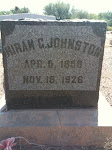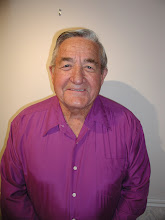
After returning home from 21 months in the United States Navy Reserve in July 1946 I was still only 19 years old. So many young men had returned from the war before me that no jobs were available. None of my family on either side had graduated from college except Uncle Orvel Johnston, who had become a CPA. I knew of the GI Bill that would pay a little to help us get a college education.
My parents offered us a part of their house to use as a small apartment to help us make it on the small amount the GI bill paid, we would not have to pay rent. So I hurried so I could attend Arizona State Teachers College of Tempe (ASTCT) that fall.
ASTCT had in the past had 500 or so students, only, but suddenly veterans came there on the GI Bill and the enrollment swelled and swelled. They moved old barracks onto the campus to use as temporary classrooms until new buildings could be built. The college wasn't ready for us so we had quite a time those first two years getting registered and deciding on majors and ect.
Mom's brother, Raymond Lamreaux owned the Mesa Lumber Company so me and my brother Gene worked there off and on for extra money. We stacked lumber, unloaded railroad cars full of sacked dry cement. It was usually very hard work. During citrus harvest I went into the groves during free time and Saturdays to pick oranges, lemons and grape fruit, getting so much for each box I would pick.
Because I was always very smart in math, my mother encouraged me to major in engineering so that was my initial major. I had to take mechanical drawing and my high school had never offered any drawing courses. It was the first class I ever had a problem with in school. I hastily attempted to change to another major to use my math ability.
I had purchased a Ford Coupe, a 1936, I think. I had mechanical brakes which didn't stop very good. I chose to hitch hike to and from school each day. I always had a school book in my hand
One of my classmates was from Thatcher, Murray Woods. Murray had a Ford like mine and one day a flat bed truck in front of us kinda stopped suddenly at Alma School and Main Street (Apache) but the mechanical brakes didn't stop us quick enough. Murray turned to the left quickly but the left rear corner of the truck bed hit the post in front of me on the passenger side. The two by four on the left side of the truck came free and went through the windshield hitting me squarely on my forehead, then stopped. It could have killed me had it came farther. I had a wound and was out a second but no lasting ill effect.
Wanda's cousin Viola Starmer came to live with us while we were in Aunt Zelma's house. She had graduated from high school in Long Beach, California and came there to spread her wings. After being in the family for awhile working at Mesa Woolworth Viola and my brother Gene started dating and soon got married. Gene was still in High School so they rented an apartment with VI's pay from Woolworth.
Shortly after we were married Wanda got a job for Bashas on the ground floor in the hotel just north of Main Street on MacDonald Street. Bashas were just beginning their chain of grocery stores in Mesa and Chandler. Our Bishop of the eighth ward was the accountant for Bashas.
Wanda had lived with Alice Kingsbury to tend her son in North Long Beach and Alice had sent
Aunt Zelma moved back to Mesa that first winter so we moved into the small apartment with a bedroom, a very small kitchen and a very small bathroom.
The summer of 1947 we baby sat Hy Hancock's home and small farm a block east of Country Club Road on Southern. He had either 10 or20 acres with cows and horses. We stayed free for taking care of the place, feeding animals and irrigating. Hy took his family, his wife, and four kids on a long tour, I think to Alaska.
As soon as the spring semester was over I got a job for AT&T putting underground cable through downtown Mesa. We tore up the sidewalks which meant I ran a jackhammer again. We dug big holes for man holes on each intersection. We ran an air tamp to pack the dirt in before we patched the sidewalk.
Most of the crew were Gene's age so I was put in charge under the project manager, who was a full time telephone company employee. He was a nice man and he had me keep time books on the employees and kept inventory on supplies and equipment. We didn't install the lines, special people did that. This job lasted all summer and was a great boost to our finances.
Wanda's father was killed in a freak accident out in Long Beach. We went out to attend services and settle his affairs. We brought her bedroom set with us when we returned to Mesa. Wanda had a brother Fred Cross in Centralia, Washington. Her other sibling was a sister much older than her. Velma and Melton Meyers lived in Las Angeles area during the war but later moved back to Salida, Colorado their hometown. Wanda was born in Salida, too.
My brother, Gene, had worked at times at a bicycle shop for Alma Millett at Soloman and Broadway in South East Mesa. I became a part time employee of Alma Millett. He sold Schwinn bicycles and repaired them. He also sold Cushman Motor Scooters and serviced them. Shortly after I went to work for Alma as bookkeeper, salesman, mechanic and delivery boy, Alma made

















 When our ship finally arrived I moved aboard it. We had to chip and paint through old rusty tanker that was our new home. A partial crew that had come from Boston remained on the ship. They included a chief signal man and a signal man, a pharmacist mate first class, and a radio man. The rest of the crew were men that had waited here in Hawaii for the ship to arrive.
When our ship finally arrived I moved aboard it. We had to chip and paint through old rusty tanker that was our new home. A partial crew that had come from Boston remained on the ship. They included a chief signal man and a signal man, a pharmacist mate first class, and a radio man. The rest of the crew were men that had waited here in Hawaii for the ship to arrive.


















